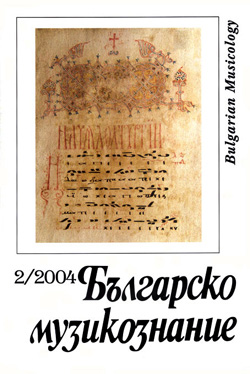Изпълнителски аспекти на византийското пеене по трактати от XIV-XV век
The Aspects of Performance of Byzantine Chant by Treatises from XV-XV century
Author(s): Denica MihaylovaSubject(s): Music
Published by: Институт за изследване на изкуствата, Българска академия на науките
Summary/Abstract: For the church music as well as for medieval art on the whole, the saving arid passing of the tradition through the ages is of great importance. In XV-XV century prominent masters, singers, writers, theorists, familiar with the art “ with exact and unerring knowledge’’, noticed the danger of “the growing ignorance” and wrong understanding and interpreting of the church music. Following the wish to keep the tradition and to send a message to the future generations, in XV century in musical manuscripts with neumatic notation appeared complete systematization and classifications of the neumatic signs, explained in treatises, appearing at the same time. Such are the of methods of these is in singing, i.e. singing through melodic formulae, by Ioannes Glykys, Ioannes Koukouzeles, Xenos Korones and the treatises of Manuel Chrysaphes and hieromonk Gabriel. The first treatises (XV century) giving more information about the aspect of performance of chant are by Manuel Chrysaphes , hieromonk Gabriel etc. The treatise of Manuel Chrysaphes had practical and educational aim, it was written for composers and singers. The author dwells upon how to compose, how to interpret the chants, what techniques of singing to use . That is why he lists six categories-abilities, which, according to the author, ought to be known and used by all. Hieromonk Gabriel explains 36 signs, so called voiceless signs, but in contrast to Chrysaphes, he touches mainly upon the problems of performance. The author searches for the origin of the names of the neumatic signs in their etymology, cheironomy and graphic. He explains the function of melodic figures and cheironomy, their place and the connection between them in chant, as “guides” of chant. From the information which the treatises give us it is understood that in the late Byzantine period every tone had its own sense and was performed in an exact definite manner. This is a great challenge for the contemporary performer of that music.
Journal: Българско музикознание
- Issue Year: 2004
- Issue No: 2
- Page Range: 90-100
- Page Count: 11
- Content File-PDF

